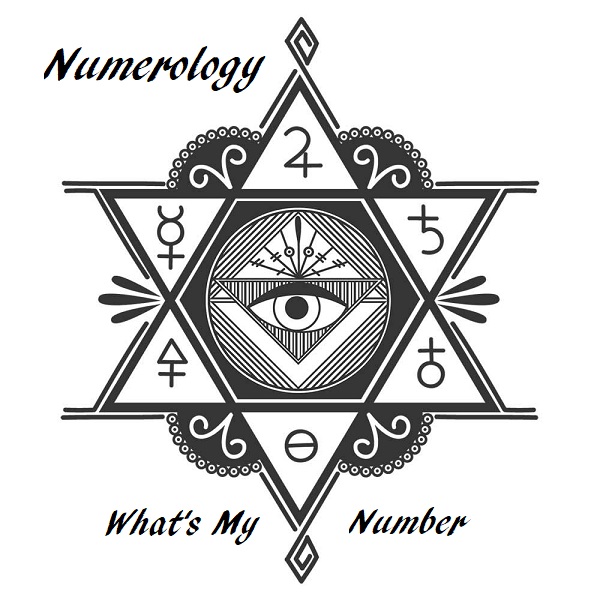Wind Chimes and the Relationship with Feng Shui and Numerology
Chiming Your Way to Harmony in Feng Shui and Numerology
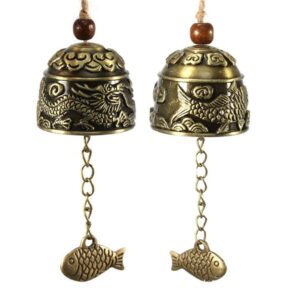
Imagine: A balmy summer night, fireflies flitting in the twilight, and a gentle breeze that carries the ethereal melody of wind chimes. Each tinkling note ripples through the air, a delicate dance of sound and energy.
These humble ornaments, though often seen as mere decorations, hold within them a rich tapestry of ancient wisdom, woven from the threads of Feng Shui and Numerology. But theirs is a story whispered, not shouted, waiting to be unravelled by those who listen closely.
The History and Cultural Significance of Wind Chimes across Different Cultures
Wind chimes have been used for various purposes in different cultures throughout history. Some people believe that wind chimes can bring good luck, ward off evil spirits, or enhance the energy of a place. Others use them for relaxation, meditation, or decoration. Wind chimes come in many shapes, sizes, and materials, such as metal, wood, bamboo, glass, or ceramic. Each type of wind chime has its own unique sound and meaning.
Ancient China – Wind chimes are more than just decorative ornaments that make pleasant sounds in the breeze. They have a long and rich history in ancient China, where they were used for various purposes, such as religious rituals, musical instruments, and symbols of status and power. In this paragraph, we will explore some of the cultural significance of wind chimes across different dynasties and regions of China.
One of the earliest records of wind chimes in China dates back to the Zhou dynasty (1046–256 BC), when they were made of bronze and hung in temples and palaces. They were believed to ward off evil spirits and attract good fortune, as well as to communicate with the gods and ancestors. The sound of the wind chimes was also used to indicate the direction and strength of the wind, which was important for agriculture and navigation.
During the Han dynasty (202 BC–220 AD), wind chimes became more elaborate and diverse, as they were crafted from various materials, such as jade, stone, wood, bamboo, glass, and metal. They were also decorated with intricate patterns and motifs, such as dragons, phoenixes, flowers, and animals. Wind chimes were not only used for religious and auspicious purposes, but also for artistic and musical ones. They were often played as part of orchestras or ensembles, or used to accompany poems and songs.
In the Tang dynasty (618–907 AD), wind chimes reached their peak of popularity and sophistication, as they were widely used by the imperial court and the aristocracy. They were regarded as symbols of elegance and refinement, and often given as gifts to foreign dignitaries and allies. Wind chimes were also integrated into the architecture and gardens of palaces and mansions, creating a harmonious and serene atmosphere. Some of the most famous wind chimes from this period are the ones found in the tomb of Princess Yongtai, which are made of gold and silver and adorned with pearls and gems.
Wind chimes continued to be used and appreciated in subsequent dynasties, such as the Song (960–1279 AD), Yuan (1271–1368 AD), Ming (1368–1644 AD), and Qing (1644–1912 AD), although their styles and functions varied according to the social and cultural changes. Wind chimes also spread to other countries and regions, such as Japan, Korea, India, Southeast Asia, and Europe, where they influenced and were influenced by local cultures and traditions.
Today, wind chimes are still popular around the world, as they are seen as objects of beauty, joy, and peace. They are also reminders of the rich and diverse history and culture of ancient China, where they originated from.
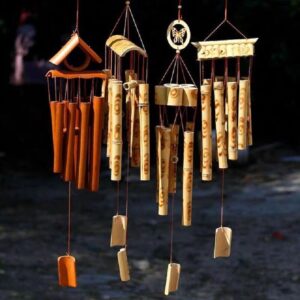
Southeast Asia – Wind chimes are more than just decorative ornaments that make pleasant sounds in the breeze. They have a long history and cultural significance across Southeast Asia, where they are used for various purposes such as warding off evil spirits, attracting good luck, enhancing feng shui, or creating a relaxing atmosphere. In this paragraph, we will explore some of the origins and meanings of wind chimes in different countries of this region.
One of the earliest recorded uses of wind chimes was in ancient China, where they were hung in temples, palaces, and homes as a symbol of harmony and balance. They were also believed to have the power to summon benevolent spirits and dispel negative ones. The Chinese often used metal or bamboo wind chimes, which produced different tones depending on the material and shape. Some of the most popular designs were the pagoda, the dragon, and the coin.
In Japan, wind chimes are called furin, which means “wind bell”. They are typically made of glass or ceramic, and have a paper strip attached to the clapper. The paper strip is often inscribed with a wish or a poem, and is said to carry the message to the heavens when the wind blows. Wind chimes are especially popular in summer, when they are hung outside to create a cooling effect and a sense of freshness. Some of the common motifs are the fish, the cherry blossom, and the crane.
In Indonesia, wind chimes are known as angklung, which are musical instruments made of bamboo tubes that are tuned to specific notes. They are played by shaking them in a rhythmic pattern, creating a harmonious sound that can range from soft to loud. Angklung are traditionally used for ceremonies, festivals, and folk music, and are considered a symbol of national identity and cultural heritage. They are also used for education and social purposes, as they promote teamwork and cooperation among the players.
Wind chimes are not only beautiful and soothing, but also rich in history and culture. They reflect the diversity and creativity of Southeast Asian people, who have used them for various reasons and meanings over time. Wind chimes are a simple yet powerful way to connect with nature, spirituality, and art.
Native American Traditions – Wind chimes are more than just decorative ornaments that make pleasant sounds in the breeze. They have a long and rich history in many Native American cultures, where they are used for various purposes such as healing, protection, and communication. In this paragraph, we will explore some of the ways that wind chimes have been integrated into the traditions and beliefs of different Native American groups.
One of the most common uses of wind chimes among Native Americans is for healing. Many tribes believe that wind chimes can balance the energy flow in the body and restore harmony to the mind and spirit. For example, the Hopi people use wind chimes made of turquoise and silver to attract positive energy and ward off negative influences. The Navajo people also use wind chimes as part of their sand painting ceremonies, where they create intricate designs on the ground with coloured sand to represent the forces of nature and the deities. The wind chimes are hung around the sand painting to amplify the power of the ritual and to invite the blessings of the wind spirits.
Another use of wind chimes among Native Americans is for protection. Some tribes hang wind chimes outside their homes or sacred places to deter evil spirits and unwanted visitors. For instance, the Apache people use wind chimes made of bones and shells to scare away enemies and animals that might harm them. The Lakota people also use wind chimes as a form of spiritual warfare, where they hang them on their horses and weapons to intimidate their opponents and to invoke the assistance of their ancestors.
A third use of wind chimes among Native Americans is for communication. Some tribes believe that wind chimes can convey messages from the spirit world or from other realms of existence. For example, the Iroquois people use wind chimes made of wood and metal to communicate with their ancestors and to honour their memory. The Cherokee people also use wind chimes as a way of connecting with their animal guides and totems, who can offer them guidance and wisdom.
Wind chimes are therefore more than just simple objects that produce sound. They are symbols of culture, spirituality, and identity for many Native American peoples, who have used them for centuries to express their values, beliefs, and traditions.
Materials used for Wind Chimes and their Symbolic Connections
Wind chimes are popular decorative items that produce soothing sounds when the wind blows. They are often made of different materials, such as metal, wood, bamboo, glass, or ceramic. Each material has its own symbolic meaning and resonance.
- Metal wind chimes are associated with strength, durability, and protection. They can also attract positive energy and wealth. Metal wind chimes are good for enhancing the metal element in Feng Shui, which is related to career, productivity, and creativity.
- Wood or bamboo wind chimes are linked to nature, growth, and harmony. They can bring healing, peace, and vitality to the environment. Wood or bamboo wind chimes are good for enhancing the wood element in Feng Shui, which is related to health, family, and abundance.
- Glass wind chimes are connected to light, clarity, and transformation. They can reflect the colours of the rainbow and create a cheerful atmosphere. Glass wind chimes are good for enhancing the fire element in Feng Shui, which is related to passion, fame, and joy.
- Ceramic wind chimes are tied to earthiness, stability, and nourishment. They can create a cosy and warm feeling in the home. Ceramic wind chimes are good for enhancing the earth element in Feng Shui, which is related to stability, security, and support.
The Basic Principles of Feng Shui and the Concept of “Chi” – the universal life force
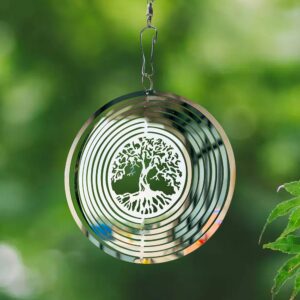
Feng Shui is a traditional Chinese practice that aims to harmonize the human and natural environments. It is based on the idea that everything in the universe has a life force or energy called “chi”. Chi flows through different pathways or channels, and can be influenced by the shapes, colours, materials, and arrangements of objects and spaces. Feng Shui practitioners use various tools and techniques to analyse the chi of a place and make adjustments to enhance its quality and balance. By doing so, they hope to improve the health, wealth, happiness, and well-being of the people who live or work there.
For centuries, Feng Shui, the Chinese art of living in harmony with the environment, has recognized wind chimes as potent allies. They are, quite literally, conduits of Chi, the vital energy that flows through all things. Their placement, materials, and even the number of their chimes hold distinct meanings and influences.
Wind Chimes are Believed to Activate and Harmonize Chi Flow within a Space
The Numerology of Wind Chimes
Wind chimes are more than just decorative ornaments that make pleasant sounds in the breeze. They are also powerful tools for attracting positive energy, harmony and prosperity into your home. But how do you choose the right wind chimes for your space? One way is to use numerology, the ancient science of numbers and their meanings.
Numerology is based on the idea that everything in the universe has a vibration, and that numbers can reveal the essence of that vibration. By adding up the digits of your birth date, you can find your life path number, which represents your purpose and destiny in this lifetime. Similarly, by adding up the digits of your house number, you can find the energy of your home and what it needs to be balanced and harmonious.
Wind chimes can help you enhance the energy of your home by matching the number of rods or tubes to your house number or life path number. For example, if your house number is 5, you can choose a wind chime with 5 rods or tubes to amplify the qualities of adventure, freedom and change. If your life path number is 9, you can choose a wind chime with 9 rods or tubes to attract compassion, wisdom and humanitarianism.
Here are some general meanings of the numbers and the types of wind chimes that correspond to them:
- 1: This number represents independence, leadership and new beginnings. A wind chime with 1 rod or tube can help you assert yourself, take initiative and start fresh.
- 2: This number represents cooperation, harmony and relationships. A wind chime with 2 rods or tubes can help you foster peace, love and partnership.
- 3: This number represents creativity, expression and joy. A wind chime with 3 rods or tubes can help you unleash your imagination, communicate effectively and have fun.
- 4: This number represents stability, structure and order. A wind chime with 4 rods or tubes can help you create a solid foundation, follow a plan and achieve your goals.
- 5: This number represents adventure, freedom and change. A wind chime with 5 rods or tubes can help you embrace new opportunities, explore new horizons and adapt to changing circumstances.
- 6: This number represents responsibility, service and family. A wind chime with 6 rods or tubes can help you care for others, contribute to society and nurture your loved ones.
- 7: This number represents spirituality, intuition and mystery. A wind chime with 7 rods or tubes can help you connect with your higher self, trust your instincts and discover hidden secrets.
- 8: This number represents power, abundance and success. A wind chime with 8 rods or tubes can help you attract wealth, influence and recognition.
- 9: This number represents compassion, wisdom and humanitarianism. A wind chime with 9 rods or tubes can help you expand your awareness, share your knowledge and serve humanity.
How to Choose the Right Wind Chime for Different Areas of your Life

Wind chimes are not only beautiful decorations, but also powerful tools for enhancing the energy flow in your home or office. Different types of wind chimes have different effects on different areas of your life, such as wealth, health, love, career, and so on. Here are some tips on how to choose the right wind chime for your needs.
- For wealth and prosperity, choose a wind chime made of metal, such as brass, copper, or silver. Metal wind chimes attract money and abundance, and also activate the metal element in the Feng Shui bagua map. Hang them in the southeast or northwest corners of your space, or near your main entrance.
- For health and well-being, choose a wind chime made of wood, such as bamboo, pine, or cedar. Wood wind chimes promote healing and growth, and also activate the wood element in the Feng Shui bagua map. Hang them in the east or south corners of your space, or near your bedroom or kitchen.
- For love and romance, choose a wind chime made of crystal, such as quartz, amethyst, or rose quartz. Crystal wind chimes enhance love and harmony, and also activate the earth element in the Feng Shui bagua map. Hang them in the southwest or northeast corners of your space, or near your bed or sofa.
- For career and success, choose a wind chime made of glass, such as stained glass, coloured glass, or clear glass. Glass wind chimes stimulate creativity and communication, and also activate the water element in the Fang Shui bagua map. Hang them in the north or west corners of your space, or near your desk or computer.
- For protection and luck, choose a wind chime with special symbols, such as coins, bells, dragons, or angels. These wind chimes ward off negative energy and attract positive energy, and also activate the fire element in the Feng Shui bagua map. Hang them in the south or centre of your space, or near your door or window.
Wind chimes can make a big difference in your life if you use them wisely and respectfully. Remember to keep them clean and dust-free, and to replace them if they break or lose their sound. Enjoy the soothing melodies and the benefits they bring to you!
Wind Chime Materials, Colours, and Placements for Optimal Energetic Benefits
Wind chimes are a popular way to add some charm and harmony to your home. But did you know that they can also affect the energy flow and balance of your space? According to the principles of Feng Shui, wind chimes can attract positive chi and ward off negative influences. But not all wind chimes are created equal. Here are some tips on how to choose the best materials, colours, and placements for your wind chimes to optimize their energetic benefits.
Materials: The material of your wind chime affects the type and quality of energy it produces. Metal wind chimes are good for enhancing the metal element in your home, which is associated with clarity, logic, and communication. They are especially suitable for the west, northwest, and north sectors of your home. Wood wind chimes are good for enhancing the wood element in your home, which is associated with growth, creativity, and abundance. They are especially suitable for the east, southeast, and south sectors of your home. Ceramic or clay wind chimes are good for enhancing the earth element in your home, which is associated with stability, nourishment, and support. They are especially suitable for the centre, southwest, and northeast sectors of your home.
Colours: The colour of your wind chime affects the mood and atmosphere of your space. You can choose colours that match the element of your wind chime material, or colours that complement the element of the sector where you place it. For example, metal wind chimes can be silver, gold, white, or grey. Wood wind chimes can be green, brown, or blue. Earth wind chimes can be yellow, beige, or orange. You can also use colours that represent your personal preferences or intentions. For example, if you want to attract more love and romance in your life, you can use pink or red wind chimes in the southwest sector of your home.
Placements: The placement of your wind chime affects the direction and intensity of energy it attracts or repels. You can use wind chimes to activate or cure certain areas of your home that need more attention or improvement. For example, if you want to boost your career prospects, you can place a metal wind chime in the north sector of your home. If you want to improve your health and well-being, you can place a wood wind chime in the east sector of your home. If you want to increase your wealth and prosperity, you can place a ceramic or clay wind chime in the southeast sector of your home. You should avoid placing wind chimes in areas where they can disturb your sleep or concentration, such as near your bedroom or study room.
Wind chimes are just one element of creating a balanced and positive environment.
The Potential Environmental Benefits of Wind Chimes as Natural Sound Elements.
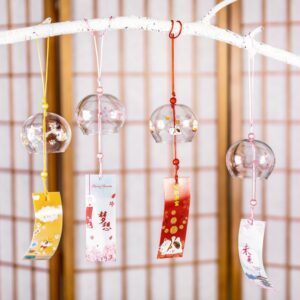
Wind chimes are not only beautiful and relaxing, but they may also have some environmental benefits as natural sound elements. Natural sound elements are sounds that are produced by natural sources, such as wind, water, birds, or insects. These sounds can help mask unwanted noise pollution, such as traffic, construction, or industrial noise, and create a more pleasant and healthy acoustic environment.
Wind chimes can act as natural sound elements because they are activated by the wind and produce soft and harmonious tones that vary depending on the size, shape, and material of the chimes. Wind chimes can also attract birds and other wildlife, which can add to the diversity and richness of the natural soundscape. Some studies have suggested that natural sound elements can have positive effects on human well-being, such as reducing stress, improving mood, enhancing cognitive performance, and promoting relaxation.
Wind chimes may also have spiritual or cultural significance for some people, as they are often used in Feng Shui, Buddhism, or other traditions to create a sense of balance and harmony. Therefore, wind chimes may be a simple and effective way to improve the quality of life and the environment by adding natural sound elements to our surroundings.
Conclusion: The Relationship with Feng Shui & Numerology
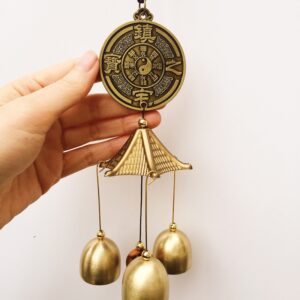
But there’s more to the chime’s secret song than merely Feng Shui and Numerology, whispers on the wind that most blogs rarely catch. The material of the chime itself carries weight. The type of sound the chime produces also plays its part. Deep, mellow tones soothe and harmonize, while crisp, high-pitched chimes energize and stimulate. Choose your melody wisely, for it will resonate with the energy you wish to cultivate in your space.
Wind chimes are more than just decorations; they are portals to a hidden world of energy and intention. Their secrets are not revealed in loud proclamations, but in the quiet whispers of the wind, the gentle clink of metal, and the subtle shifts in your own energy field. Take time to listen, to feel the way their music dances around you, and witness the transformation it works upon your space and your soul.
So, the next time you find yourself beneath a swaying chime, don’t simply admire its beauty. Close your eyes, listen closely, and let the wind carry you away on a journey of harmony, intention, and the ancient whispers of the universe.
Stats to Ponder:
- A 2023 survey by the American Feng Shui Society found that 58% of respondents use wind chimes for their aesthetic appeal, but 42% also recognize their potential for attracting positive energy.
- A study by the University of California, Berkeley, showed that listening to the sounds of nature, including wind chimes, can significantly reduce stress and anxiety.
- The global wind chime market is estimated to reach $520 million by 2027, driven by growing interest in holistic wellness and mindfulness practices.
This is just the beginning of the melody. Dive deeper into the fascinating world of wind chimes, Feng Shui, and Numerology, and unlock the secrets your own chimes might be whispering. The music awaits, waiting to be heard.
